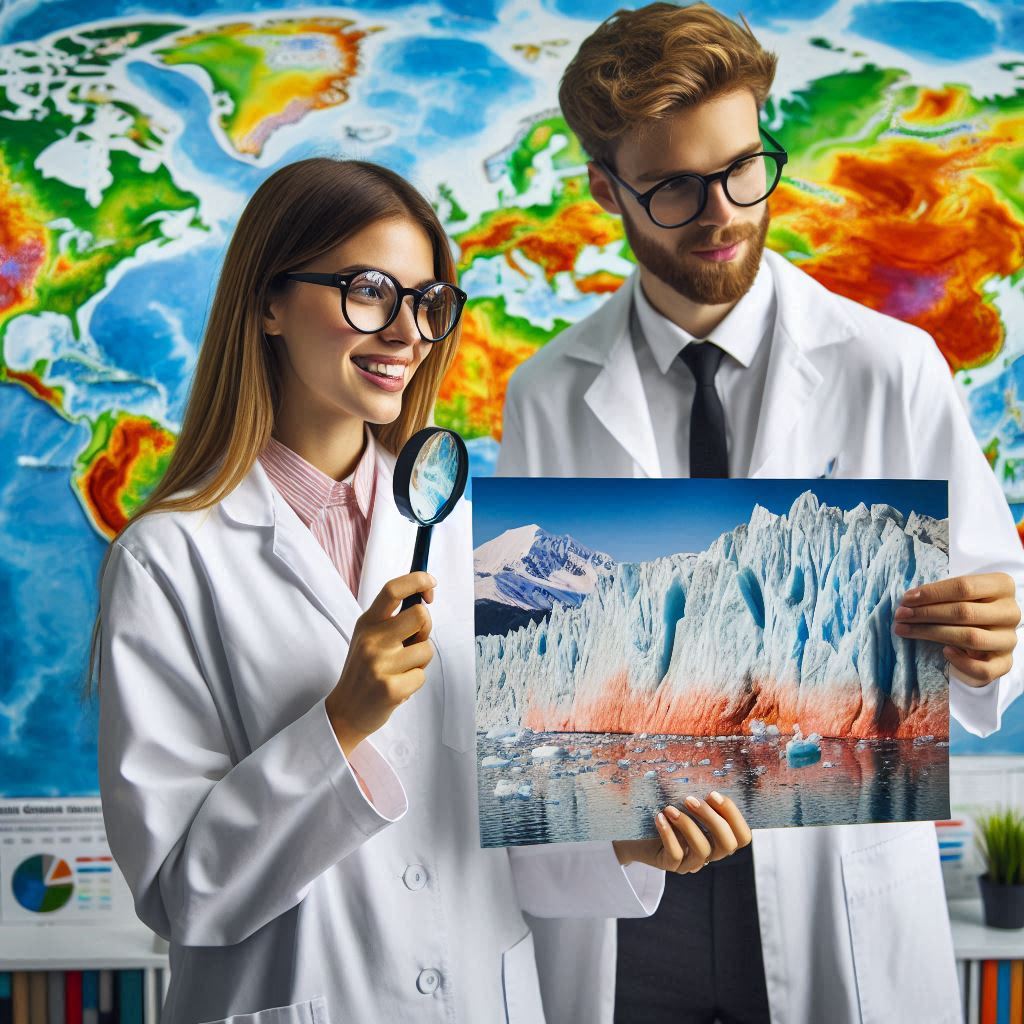Introduction
Climatology plays a crucial role in understanding and addressing the global challenges we face today.
As climate change intensifies, the study of climate patterns has become more vital than ever.
Climatologists focus on analyzing weather data, studying atmospheric processes, and predicting future climate trends.
These insights help governments, organizations, and individuals prepare for and adapt to changing environments.
Without climatology, we would lack the necessary information to make informed decisions on sustainability and disaster preparedness.
The importance of climatology lies in its ability to identify changes in the Earth’s climate over time.
By examining long-term weather patterns and environmental shifts, climatologists contribute to our understanding of global warming and its impacts.
Rising temperatures, melting ice caps, and extreme weather events are all pressing issues that climatologists seek to address through their research.
These studies provide valuable data to policymakers and environmental advocates, guiding actions to mitigate climate change effects.
Several key research areas are currently shaping the field of climatology.
One major focus is the study of extreme weather events, such as hurricanes, heatwaves, and floods.
Researchers analyze how these events are increasing in frequency and intensity due to climate change.
Understanding these patterns helps communities prepare for disasters and develop strategies to reduce harm.
Extreme weather research also informs efforts to improve early warning systems and disaster response planning.
Climate Change
Climate change continues to have a profound impact on global temperatures.
It plays a significant role in altering weather patterns worldwide.
Scientists have been closely monitoring these changes to understand their causes and effects better.
Impact of Climate Change on Global Temperatures
One of the most noticeable effects of climate change is the rise in global temperatures.
The Earth’s average temperature has been steadily increasing over the past century.
This phenomenon, known as global warming, is primarily caused by the increase in greenhouse gases in the atmosphere.
Greenhouse gases, such as carbon dioxide and methane, trap heat in the Earth’s atmosphere.
As their levels continue to rise due to human activities like burning fossil fuels and deforestation, more heat is retained, leading to a rise in global temperatures.
The consequences of rising global temperatures are widespread.
They result in more frequent and intense heatwaves, droughts, and wildfires in many regions.
The melting of polar ice caps and glaciers also accelerates, contributing to rising sea levels and coastal flooding.
Scientists have been studying the impacts of global warming on various ecosystems, including coral reefs, forests, and Arctic habitats.
They have observed disruptions in biodiversity, changes in migration patterns of animals, and increased extinction risks for many species.
Current research efforts to understand the causes and effects of climate change
To better grasp the causes and effects of climate change, researchers have been conducting a wide range of studies.
These studies aim to enhance our knowledge of the Earth’s climate system and predict future changes more accurately.
One key area of research is studying the role of human activities in driving climate change.
Scientists investigate how emissions from industries, transportation, and agriculture contribute to greenhouse gas concentrations in the atmosphere.
Researchers also focus on understanding natural factors that influence the Earth’s climate.
They study phenomena like volcanic eruptions, solar variability, and ocean currents to determine their impact on global temperatures and weather patterns.
Another vital research area is developing climate models that simulate the Earth’s climate system.
These models help scientists make projections about future climate scenarios based on different emission scenarios and climate feedback mechanisms.
Efforts are also underway to improve climate monitoring techniques and data collection.
Scientists utilize satellites, weather stations, and ocean buoys to gather essential data on temperature, precipitation, sea level rise, and other climate-related parameters.
Collaborative international research projects, such as the Intergovernmental Panel on Climate Change (IPCC), play a significant role in synthesizing and communicating scientific knowledge on climate change.
These efforts help policymakers make informed decisions to mitigate and adapt to the impacts of climate change.
In short, addressing climate change requires a concerted effort from the scientific community, policymakers, industries, and individuals.
By advancing research in key areas like understanding the causes and effects of climate change, we can take proactive measures to protect our planet and build a sustainable future for generations to come.
Read: U.S. Cities with the Most Opportunities for Environmental Scientists
Extreme Weather Events
The Frequency and Intensity of Extreme Weather Events Such as Hurricanes, Floods, and Droughts
Extreme weather events, including hurricanes, floods, and droughts, have become more frequent and intense in recent years.
Climatologists focus heavily on understanding these phenomena to predict their occurrence and minimize their devastating impacts.
Research shows that climate change has amplified the severity of these events, creating a pressing need for advanced studies.
Hurricanes have increased in strength, causing greater damage to coastal communities.
Rising sea surface temperatures contribute to this intensification, fueling more powerful storms.
Climatologists study ocean heat content, wind patterns, and atmospheric conditions to improve hurricane forecasts.
By analyzing data from past storms and simulating future events, researchers aim to provide more accurate predictions.
Flooding is another major concern, especially in urban areas.
Increased rainfall, coupled with poorly designed drainage systems, has led to more frequent and severe floods.
Climatologists analyze historical rainfall data and use climate models to predict future flood risks.
They work with urban planners to design more resilient infrastructure that can withstand heavy rains.
These efforts help reduce the loss of lives and property during extreme flood events.
Droughts, on the other hand, pose a significant threat to agricultural regions and water supplies.
Prolonged periods of little rainfall can lead to crop failures, water shortages, and economic instability.
Climatologists monitor soil moisture levels, precipitation patterns, and water reservoirs to assess drought risks.
Ongoing research focuses on understanding the links between climate change and drought severity.
This knowledge helps policymakers implement water conservation measures and prepare for long-term drought conditions.
Ongoing Studies to Better Predict and Mitigate the Impact of These Events on Communities
One key area of research in extreme weather events is the development of early warning systems.
These systems aim to provide communities with more time to prepare and evacuate if necessary.
Researchers use satellite data, weather models, and ground sensors to detect changes in atmospheric conditions.
By improving the accuracy of these systems, climatologists can save lives and reduce economic damage.
Mitigation strategies are also an important aspect of research on extreme weather.
Climatologists collaborate with engineers and policymakers to develop solutions that reduce vulnerability to these events.
Building stronger infrastructure, restoring wetlands, and reforesting areas are some strategies used to protect against floods, hurricanes, and droughts.
These actions help communities become more resilient in the face of extreme weather.
Basically, research on extreme weather events is crucial for predicting, preparing for, and mitigating their effects.
Climatologists play a key role in understanding the science behind these events and providing practical solutions.
By improving forecasts and developing sustainable infrastructure, they help protect communities and minimize the impact of extreme weather.
This ongoing research continues to evolve as new data and technologies emerge.
Read: Environmental Scientist vs. Ecologist: Roles and Differences in the US
Climate Modeling
The use of computer models to simulate past and future climate conditions
Climate modeling uses advanced computer simulations to replicate both past and future climate conditions.
These models integrate data from various sources, including atmospheric patterns, ocean currents, and human activities.
By analyzing these factors, climate models provide valuable insights into how Earth’s climate has evolved and will continue to change.
One key aspect of climate modeling is the ability to simulate past climate conditions accurately.
By using historical data, researchers can test the reliability of models by comparing their results with known events.
Accurate past simulations build confidence in the models’ predictions for future climate scenarios.
This process helps researchers understand the causes of climate changes and identify patterns that may inform future trends.
The advancements in climate modeling techniques and their implications for our understanding of climate dynamics
Advancements in climate modeling techniques have significantly improved our understanding of climate dynamics.
Improved computing power allows for the creation of more detailed models that account for small-scale processes like cloud formation and ocean-atmosphere interactions.
These finer details help scientists capture the complexity of the Earth’s climate system and improve the accuracy of long-term predictions.
One major breakthrough in climate modeling is the development of Earth System Models (ESMs).
These models go beyond basic temperature and weather patterns by including biological, chemical, and physical processes.
ESMs track interactions between land, oceans, and the atmosphere, offering a more comprehensive view of the climate system.
This holistic approach allows researchers to analyze feedback loops, such as how warming temperatures affect carbon sinks, leading to more warming.
Climate modeling also helps scientists explore the impacts of various emissions scenarios.
By simulating different levels of greenhouse gas emissions, models can predict how future temperatures, sea levels, and weather patterns might change.
This information helps policymakers develop strategies to mitigate or adapt to climate change.
For example, if a model shows that reduced emissions can slow the rate of global warming, governments may be more likely to invest in sustainable energy sources.
These advancements in climate modeling have important implications for understanding climate dynamics.
They allow scientists to better predict extreme weather events, such as hurricanes and droughts, which can inform disaster preparedness efforts.
Additionally, improved climate models help researchers study regional climate changes, allowing for more accurate local predictions.
This is especially valuable for communities vulnerable to climate change, such as coastal areas facing rising sea levels.
In short, climate modeling is essential for understanding both historical and future climate changes.
Technological advancements in climate modeling have made it possible to predict climate patterns with greater accuracy.
These tools help researchers, policymakers, and communities better prepare for the impacts of climate change, ensuring a more informed and resilient society.
Read: The Relationship Between U.S. Policy & Environmental Scientist Roles

Polar Ice Melt
The polar ice caps are melting at an alarming rate.
Scientists closely monitor the Arctic and Antarctic regions for changes.
In recent years, satellite data has revealed significant ice loss in these areas.
The Arctic is warming faster than other regions, leading to increased melting.
The Antarctic is also experiencing ice sheet loss, especially in West Antarctica.
The Rate of Melting Ice in the Arctic and Antarctic Regions
Researchers have documented a dramatic increase in ice loss in both polar regions.
The Arctic is losing approximately 13 percent of its ice cover per decade.
Satellite observations indicate that Greenland’s ice sheet is losing mass at unprecedented rates.
The Antarctic ice sheet also shows signs of instability, with several glaciers retreating rapidly.
The consequences of this accelerated melting raise urgent concerns.
The interplay between rising temperatures and melting ice presents a dire challenge.
Continued research focuses on understanding the mechanisms behind this ice loss.
This knowledge is crucial for predicting future changes in polar ice.
The Potential Consequences of Polar Ice Melt on Sea Levels and Global Climate Patterns
As polar ice melts, it contributes to rising ocean levels.
Even a small increase in sea levels can have severe consequences.
Coastal communities may face flooding and erosion due to rising waters.
Major cities like New York and Miami are particularly vulnerable.
Additionally, polar ice melt affects global climate patterns.
Ice reflects sunlight, helping to regulate Earth’s temperature.
As ice diminishes, darker ocean water absorbs more heat.
This feedback loop leads to further warming and ice loss.
The changes in temperature influence weather patterns around the globe.
Polar ice melt also impacts ocean circulation.
The influx of fresh water from melting ice disrupts currents.
These currents play a crucial role in regulating climate.
Altered ocean circulation can lead to extreme weather events, including hurricanes and droughts.
Scientists warn that we may see more frequent and intense storms.
Moreover, the loss of ice habitat threatens polar ecosystems.
Many species depend on ice-covered regions for survival.
For example, polar bears rely on sea ice to hunt seals.
As ice diminishes, their hunting grounds shrink, endangering their populations.
Melting ice also releases trapped greenhouse gases.
Permafrost contains vast amounts of carbon dioxide and methane.
As it thaws, these gases enter the atmosphere, exacerbating climate change.
This creates a dangerous cycle that accelerates warming trends.
To address these challenges, researchers are studying the implications of polar ice melt.
Understanding the rate of ice loss helps predict future sea-level rise.
Scientists use climate models to assess potential impacts on global weather patterns.
Their findings inform policymakers and guide climate action strategies.
Public awareness is crucial in combating climate change.
Educating communities about the consequences of polar ice melt can drive action.
Collective efforts can help mitigate the effects of climate change and protect vulnerable regions.
In fact, polar ice melt poses significant threats to both the environment and society.
Continued research and public engagement are essential to address these pressing issues.
Only through collaboration can we hope to safeguard our planet’s future.
Read: Organizations & Associations for Environmental Scientists in the USA
Ocean Acidification
The Increasing Acidity of the World’s Oceans Due to Carbon Dioxide Absorption
Ocean acidification is a pressing issue caused by increasing carbon dioxide (CO?) levels in the atmosphere.
When CO? is absorbed by ocean water, it reacts with seawater, forming carbonic acid.
This process lowers the pH of the ocean, making it more acidic over time.
Since the Industrial Revolution, ocean acidity has increased by about 30%.
This trend poses serious threats to marine ecosystems and biodiversity.
Marine organisms depend on specific pH levels to thrive.
Acidification disrupts these conditions, affecting species that rely on calcium carbonate.
Shellfish, coral reefs, and certain plankton species struggle to form their shells and skeletons.
As a result, their populations decline, impacting the entire food web.
Coral reefs, in particular, are vulnerable to acidification.
These ecosystems provide habitat for countless marine species and support fisheries.
A decrease in coral health threatens biodiversity and coastal communities that depend on these resources.
The Impact of Ocean Acidification on Marine Life and Ecosystems
Moreover, ocean acidification affects fish behavior and physiology.
Studies show that elevated acidity levels impair fish sensory functions.
Fish may struggle to detect predators or find food, reducing their chances of survival.
Changes in behavior can alter fish populations, affecting the balance of marine ecosystems.
This disruption can have cascading effects on the fishing industry, which relies heavily on healthy fish stocks.
The implications of ocean acidification extend beyond marine life.
Coastal communities depend on fishing and tourism for their livelihoods.
As marine species decline, economic stability may suffer.
Coral reefs, vital for tourism, also face degradation, leading to loss of income for local economies.
Additionally, ocean acidification may influence global food security.
A decline in seafood availability could impact nutrition for millions of people worldwide.
Researchers are actively studying ocean acidification to understand its long-term effects.
They employ various methods, including laboratory experiments and field studies.
These investigations aim to assess how different species respond to changing acidity levels.
Understanding these responses helps predict future impacts on marine ecosystems.
Scientists also examine potential mitigation strategies to address ocean acidification.
Efforts include reducing CO? emissions and enhancing marine protected areas.
All in all, ocean acidification represents a critical challenge in climatology today.
Its increasing impact on marine life threatens ecosystems and economies worldwide.
As researchers continue to explore this issue, raising public awareness remains crucial.
Society must act to mitigate CO? emissions and protect ocean health.
Our oceans play an essential role in regulating the climate and supporting life on Earth.
Addressing ocean acidification is vital for the future of our planet.
Urban Heat Islands
Definition Urban Heat Islands and Their Effect on Local Temperature Trends
Urban heat islands (UHIs) are areas in cities that experience significantly higher temperatures than their rural surroundings.
These temperature differences arise from human activities and urban infrastructure.
Factors contributing to UHIs include concrete, asphalt, and reduced vegetation.
Buildings and roads absorb heat during the day and release it slowly at night.
This leads to higher overall temperatures in urban areas.
As a result, cities often experience hotter conditions than nearby rural regions.
The UHI effect can lead to several adverse consequences.
Elevated temperatures can increase energy demand for cooling systems.
This places additional stress on power grids and increases greenhouse gas emissions.
Higher temperatures also contribute to poor air quality and can exacerbate health issues.
Vulnerable populations, such as the elderly and low-income communities, face the greatest risks.
Addressing the UHI effect is crucial for improving public health and enhancing urban resilience.
Strategies to Reduce the Heat Island Effect in Cities and Improve Urban Climate Resilience
Research on strategies to reduce urban heat islands focuses on several innovative approaches.
One effective method involves increasing vegetation in urban areas.
Planting trees and creating green roofs can significantly lower local temperatures.
Trees provide shade and release moisture through transpiration.
This cooling effect can help mitigate the UHI phenomenon.
Green roofs, covered with vegetation, can also absorb sunlight and reduce heat absorption by buildings.
Another strategy includes using reflective materials in urban construction.
Light-colored roofs and pavements can reflect sunlight rather than absorbing it.
This practice, known as cool roofing, helps lower surface temperatures.
Researchers emphasize the importance of integrating cool roofing practices in city planning.
Implementing these materials can effectively reduce the overall urban temperature.
Additionally, urban planners can design cities with more open spaces.
Parks and water bodies help lower temperatures in their immediate surroundings.
Research shows that incorporating parks into urban designs can enhance community well-being.
Water features, such as fountains and ponds, provide cooling effects during hot weather.
Cities worldwide are adopting these strategies to improve climate resilience.
Urban heat island mitigation measures are becoming a priority in climate action plans.
Policymakers are recognizing the importance of addressing UHI effects.
Effective strategies not only improve local climates but also enhance urban living conditions.
Communities that prioritize these measures foster a healthier environment for residents.
Most importantly, urban heat islands significantly impact local temperature trends and public health.
Ongoing research highlights the importance of implementing effective strategies to combat the UHI effect.
By increasing vegetation, using reflective materials, and designing open spaces, cities can enhance their climate resilience.
Uncover the Details: Immunologist vs. Virologist: Career Differences
Transform Your Career Today
Unlock a personalized career strategy that drives real results. Get tailored advice and a roadmap designed just for you.
Start NowClimate Adaptation Strategies
The Importance of Developing Adaptive Strategies to Cope with Changing Climate Conditions
As climate change accelerates, developing adaptive strategies is crucial for coping with its impacts.
Communities worldwide face rising temperatures, extreme weather events, and shifting ecosystems.
Climate adaptation strategies help mitigate these risks and enhance resilience.
Adaptation focuses on modifying human systems to withstand climate-related challenges.
It involves understanding vulnerabilities and implementing targeted actions.
Developing effective strategies requires collaboration between governments, scientists, and communities.
Stakeholders must engage in discussions about local conditions and needs.
Ongoing Research on Sustainable Solutions and Policies to Address Climate-Related Challenges
Ongoing research highlights innovative solutions to address climate challenges.
Scientists investigate sustainable practices across various sectors, including agriculture, urban planning, and water management.
For instance, researchers study drought-resistant crops to support food security amid changing weather patterns.
These crops can thrive in arid conditions, reducing dependence on water resources.
In urban areas, climate adaptation includes enhancing infrastructure resilience.
Researchers explore green building practices that utilize sustainable materials and energy-efficient designs.
Implementing green roofs, rain gardens, and permeable pavements can manage stormwater effectively.
These solutions mitigate flooding risks while improving urban aesthetics.
Coastal communities face significant threats from rising sea levels.
Scientists are studying natural barriers, such as wetlands and mangroves, to protect shorelines.
Restoring these ecosystems provides vital habitats for wildlife and acts as buffers against storm surges.
Moreover, these areas store carbon, contributing to climate change mitigation.
Policy development plays a key role in climate adaptation strategies.
Governments must create frameworks that support sustainable practices and research initiatives.
Policymakers should prioritize funding for climate adaptation projects and encourage stakeholder involvement.
Engaging local communities ensures that strategies align with their unique needs and challenges.
Research also emphasizes the importance of education and public awareness.
Raising awareness about climate change and adaptation strategies empowers individuals to take action.
Educational programs can inform communities about sustainable practices they can adopt.
Encouraging citizen participation in local adaptation initiatives fosters a sense of ownership.
Basically, climate adaptation strategies are essential for addressing the challenges posed by climate change.
Ongoing research focuses on sustainable solutions across various sectors, including agriculture, urban planning, and coastal management.
By developing adaptive strategies, communities can enhance resilience and better cope with changing climate conditions.
Through collaboration, policy development, and public engagement, society can effectively respond to climate-related challenges and secure a sustainable future.
Discover More: The Role of Geologists in Natural Disaster Response
Conclusion
In this blog post, we explored vital research areas in climatology.
These areas include climate modeling, extreme weather analysis, and climate impacts on ecosystems.
We also examined the role of climate change in agriculture and water resources.
Each research focus contributes to our understanding of climate change and its effects.
Climate modeling helps scientists predict future climate scenarios.
It allows us to assess potential risks and develop strategies for mitigation.
By improving these models, researchers can enhance their accuracy and reliability.
This progress is crucial for effective climate action.
Extreme weather analysis studies the increasing frequency and intensity of weather events.
Researchers investigate storms, heatwaves, and droughts.
Understanding these patterns helps communities prepare for and adapt to these challenges.
As climate change continues to influence weather, this research remains vital.
The study of climate impacts on ecosystems reveals the interconnectedness of our planet.
Researchers examine how rising temperatures and shifting precipitation patterns affect biodiversity.
Protecting ecosystems is essential for maintaining ecological balance and human well-being.
Ongoing research in this area will help develop strategies for conservation.
[E-Books for Sale]
The Big Book of 500 High-Paying Jobs in America: Unlock Your Earning Potential
$19.99 • 500 High-Paying Jobs • 330 pages
Explore 500 high-paying jobs in America and learn how to boost your career, earn more, and achieve success!
See All 500 High-Paying Jobs of this E-Book
1001 Professions Without a Degree: High-Paying American Jobs You Can Start Now
$19.99 • 1001 Professions Without a Degree • 174 pages
Discover 1001 high-paying jobs without a degree! Unlock career tips, skills, and success strategies for just $19.99!




